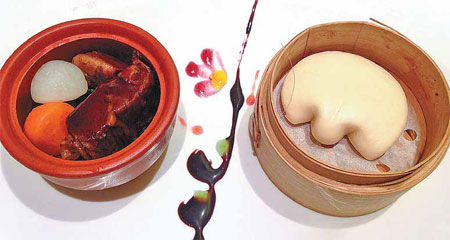Hengshan hideaway
Updated: 2013-03-31 08:22
By Pauline D. Loh (China Daily)
|
|||||||||||
|
A tiny bowl of braised beef and radishes came with a delicate lotus-leaf shaped steamed bun. Photos by Pauline D. Loh / China Daily |
Deep in the old French Concession, a thoroughly modern facade looks onto a street full of Rodeo Drive type boutiques. Pauline D. Loh plumbs the hidden delights.
The magnolias are magnificent. In the bright sunshine of the Shanghai spring, the soft pink and white blooms dazzled the eyes as they commanded pride of place within the central atrium garden of the new Twelve at Hengshan hotel.
My cabdriver had been surprised there was such a posh hotel along that familiar road.
No wonder, since the hotel only opened late last year. I am sure, however, it is going to be a firm favorite among the elite Shanghai visitors who lean toward a more aesthetic choice in accommodation.
It is a Starwood hotel under its Luxury Collection, which is a sure guarantee of quality, but it is also a high-end business boutique hotel that is only six stories high and awash with junior and grand suites.
It stands to reason then that its Chinese restaurant should be up to entertaining the best palates in town.
The decor is very pleasing, and well decorated without being intimidating as with many upmarket restaurants.
The menu is largely Cantonese, designed by Singaporean-Chinese chef Chung Kuy Fai, who'd cut his culinary teeth in America, and later in China, with an illuminating stint at Jereme Leung's famous Whampoa Club on the Bund.
However, it being Shanghai, you can still see many benbang (local Shanghainese) characteristics, such as the classic braised wheat gluten kaofu appetizer and a use of the miniature vegetables so beloved by local gourmets.
We had first pea shoots of the season blanched in rich golden chicken stock and topped with quivering squares of fried beancurd garnished with a seaweed hat and deep-fried shredded scallops. The flavors were intricately layered and textured.
We had a tasting menu, and the chef, delighted that I was a countryman, went all out to accommodate my quirks.
I wanted the sweet braised wheat gluten, and so it came in the starter tasting platter, together with richly caramelized Wuxi-style pork ribs, a piece of the Jiangsu sweet smoked fish, and a beautiful mouthful of salad leaves bound by a cucumber ring and drizzled with a smoky sesame dressing.
A tiny bowl of braised beef and radishes came with a delicate lotus-leaf shaped steamed bun, and I really enjoyed that. The beef is the best Wagyu, and fell apart in the mouth while still retaining all its flavor in spite of the long cooking. The bun helped soak up all the juices, an inspired if unusual pairing that got my attention and appreciation.
The staple was fried rice served in a bamboo container. It did not look like anything special until you actually ate a spoonful. Then the savory smoked meats made their presence felt.
I will not say desserts are a particular weakness, but this one seduced me. It was a platter of almond tea, an almond tart, almond jelly and finally, just candied almonds.
Almond tea is a Cantonese classic sweet soup that clears the lung during the muggy seasons like spring and autumn. The chef's version was rich without overpowering and was elegantly aromatic. The almond tart is very like the Macanese egg tarts, but the filling is a light egg white custard flavored with almonds.
The almond jelly, served with a few seeded longans, brought me right back to childhood to my first wedding dinner. It is an extremely popular meal-ender in Cantonese banquets for all occasions.
And finally, as we ended the meal with freshly brewed Chinese oolong tea, the candied almonds were the final jewel to the crown.
Contact the writer at paulined@chinadaily.com.cn.
Today's Top News
Police continue manhunt for 2nd bombing suspect
H7N9 flu transmission studied
8% growth predicted for Q2
Nuke reactor gets foreign contract
First couple on Time's list of most influential
'Green' awareness levels drop in Beijing
Palace Museum spruces up
Trading channels 'need to broaden'
Hot Topics
Lunar probe , China growth forecasts, Emission rules get tougher, China seen through 'colored lens', International board,
Editor's Picks

|

|

|

|

|

|






